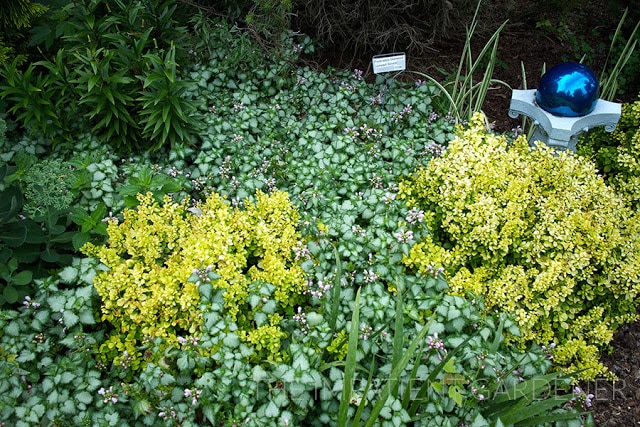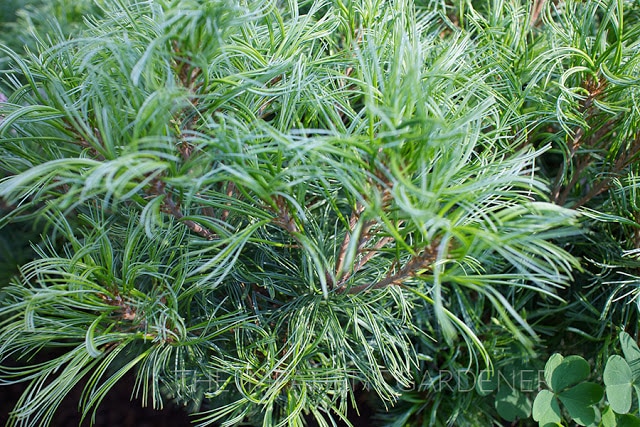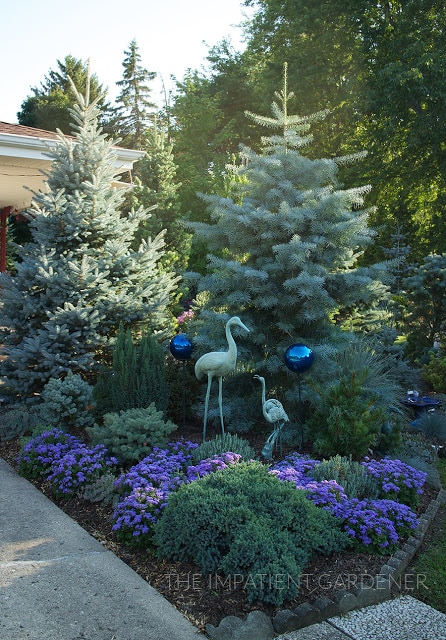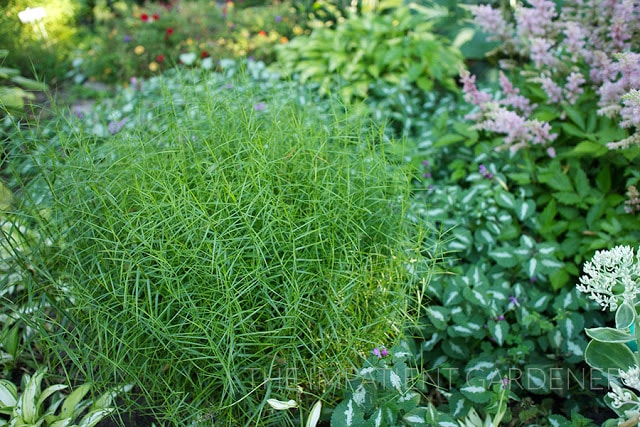I have never toured a garden and not taken something away from it that I want to put into practice or plant in my own garden. If you ever feel like you’re in a gardening rut, it is the single most inspirational thing you can do.
The garden I visited a few weeks ago was one of the most impressive private gardens I’ve visited. It was started in the mid-1970s when only three trees stood on the city property (it’s about a third of an acre). The gardener, a lovely dedicated woman who told me she has spend most of her day in the garden from April to October for the last 40 years, discovered early on that the garden is on heavy clay soil. She became a great proponent of compost and makes copious amounts of the stuff, throwing it on anywhere she can.
In addition to a fascination with conifers as well as a few other additions to my must-have plant list, here are some of my take aways from this tour:
- Make every plant accessible. Every bit of the garden was accessible by paths or by being cut into sections with grass paths between. I think you probably could have reached every plant without stepping in a bed.
- Hide the ugly stuff. Rather than be greedy and take as much space as possible for the garden, she did a double fence on the side of the property. One abuts her neighbor’s yard. Another identical fence is located about 10 feet inside of the first and she hides all of the ugly bits in between. A huge composting area, collections of nursery pots, wheelbarrows, etc.
- Have a beautiful enough garden and your house doesn’t matter. Beyond recalling that it was a one-story house, I have no idea what the house looked like.
 |
| Great use of lamina as a groundcover. |
 |
| Her brunnera were all huge. Unfortuantely I don’t know the shrub. Anyone recognize it? |
 |
| Another great plant combination: heliopsis and daylilies. |
 |
| Pinus strobus ‘Tiny Kurls’ |
 |
| The path to the front door is marked by her Rhapsody in Blue garden, full of blue plants. |
 |
| Amsonia pops up again. It WILL be in my garden next year. |
If this garden proves anything, it’s one of the things that has taken me the longest to learn about garden design: Texture, perhaps more than anything, is so important. Of course there are many elements to garden design—size, structure, color, arrangement—but without texture, all of these fall flat.
There are so many lessons to take away from every garden, but this one was particularly inspirational. What a delight to be able to spend some time in it.






19 Responses
Wow! This is a garden of so many layers, textures, and shapes. Do you know the name of the tall, thin weeping evergreen tree in this last picture (in the left background and the center very back)?
It is a picea glauca pendula
Thanks Anonymous! Yep, I believe that's correct.
I've toured a few gardens this year. I've taken away that I get lazier and lazier while, seemingly, other people get more energetic.
Love the blue and all the conifers. Question for you: how is your Beth's Blue laurentia doing? Mine went sharply downhill after Fourth of July. Worth planting again because I loved them up until that point. But now they look dead or are covered in lush green growth but no blooms.
The lesson I took away from tours this summer is scale of plants to each other and the larger landscape. This woman clearly has that in spades. 40 years sure gets you some nice size trees and shrubs. I just planted 7 shrubs and her garden makes me think I need lots more.
I want more conifers in the garden which is my take away from tours this year. This garden makes me realize that I need all that texture. Beautiful.
That shrub is a variegated Fallopia japonica. I'd be weary of it.
Why wary?
Anonymous: You might be more familiar with the common name: Japanese knotweed. This variegated form is, in general, better behaved, but because Japanese knotweed is such an incredibly invasive plant (in my area there are programs where the state will actually pay contractors to remove it for you), if you choose to plant this, you'd be better off to contain it like you would with a running bamboo.
Note that there are some forms of this plant that are nearly sterile and send up nearly no runners. Here's one from the Plants Delight website: http://www.plantdelights.com/Polygonum-cuspidatum-Freckles-for-sale/Buy-Freckles-Mexican-Bamboo/
I just found your blog and bookmarked it. I could read this post all day and learn something new every five minutes – and I've been gardening most of my 70 years. The woodland garden path (8th photo from top) is especially lovely. Color and texture are done so well here and the symmetry is very appealing. I also have an affinity for garden paths, so that one was pinned to think about and try to incorporate into my garden. I also love that the gardener made it possible to reach every plant without stepping in a bed. That's hard to do and still have the lush and full look she has. So much in this post. Thank you!
Recently visited a garden filled with confers too. It was interesting to see all the textures and colours. Always thought they were so boring until seeing that garden. This conifer collection adds so much colour and yet grounds the garden at the same time.
I'm like you when it comes to running my eye over a beautiful yard …and never noticing the house. This one's a beaut! My favorite – and new to me – is the amsonia. Gorgeous texture!
I love all the texture and color play in your garden. Beautiful job.
This comment is over 5 years after the post was made, but wanted to say that the plant next to the Brunnera looks like ‘Painter’s Palette’ Persicaria virginiana. It is sometimes called Painter’s Palette Knotweed. While it is fast growing, it is not the invasive type of knotweed. To keep the plant from spreading rapidly, my mother-in-law clips the red berry seeds as they sprout and discards.
I would love to see this garden now 6 years later . I’d love to see how it has changed as well as some plant identification. Love your YouTube videos Erin!
In her blue garden, how did she ‘suspend’ the gazing balls in the air? Also what is that weeping looking evergreen in the last photo?
Just reading this post 2022…I agree that this garden should have a revisit to see all the textures.
The blue gazing balls are on hooks hidden in the conifers. Which is brilliant idea and it’s going to be a take away for me.
Thanks to Erin for all her talent. Merry Christmas to all gardeners.